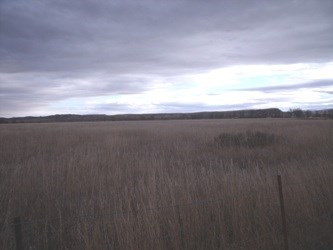
Hebard and Brininstool, The Bozeman Trail 
NPS A Busy Day Richards, the civilian haycutting contractor, started cutting hay early that morning. The scene of the operation was in the Bighorn Valley, about two and one-half miles northeast of the fort. The Fortified Corral On the south side a wagon's running gears were placed in the entrance and the wheels were chained to the entrance posts at night. Inside the corral, on the west wall, were four wagon boxes in a row with their bows and canvas tops. Three military tents were pitched north of the wagon boxes. A line, to which the livestock were tethered at night, ran the length of the corral, north to south. The field kitchen stood just outside at its southwest corner. This location, though ideal for harvesting hay, had one significant disadvantage; it could not be seen or heard from the fort. Technological advantage Under Attack At first, the Sioux warriors made several dashes at the corral and then fell back, trying to entice the soldiers out of the corral and into an ambush. Lieutenant Sternberg refused to fall for this ruse and kept his men employed strengthening the defenses. The warriors realized that their tactics were not working, so they withdrew and regrouped. Later, they made a cautious approach from the northeast. The haycutters and soldiers, seeing the warriors approaching, threw themselves on the ground behind the fence and wagon boxes. Sternberg, a veteran of many battles, refused to fight on his belly. He drew his revolver and stood tall. The First Casualties After Sergeant James Norton was wounded, Don A. Colvin, a civilian, took charge of the fight. He called for everyone to stay on the ground and fight from behind the lower log. During this action, private Navin met his end, as one of the warriors hit his mark. Their initial attack repulsed the Indians as they took up sniping positions on the bluffs to the southeast, and in the willows that lined War Man Creek.

NPS Burn Them Out The Indians used this cover to retrieve their dead and wounded. Then they made their second attack. Two defenders were wounded during this assault; J.G. Hollister was severely wounded in the chest and died the next day, and Sergeant Norton was again wounded in the shoulder. Water and War The warriors made two mid-afternoon charges. Sweeping down from the bluffs south of the strongpoint, the Indians galloped back and forth along the west side of the corral. During this time, a warrior, believe to be a medicine man, was shot by George Duncan. He was rescued by several warriors and carried back to their camp. The Final Attack & A Ride To Help Private Bradley now volunteered to ride to the fort for help. Although chased by several hostiles, he made it to the fort just after Captain Burrowes had moved out with Company G. Colonel Bradley now ordered Lieutenant Fenton to reinforce Burrowes with a detachment of Company H, and a Mountain Howitzer. They reached the corral at sundown. Relief and the Return During the days after the fight, Lieutenant Sternberg, Private Navin, J. G. Hollister were laid to rest in the cemetery. Three days later, on August 5, Lieutenant Fenton, with 50 men and a mountain howitzer, re-established the hay corral in the valley. The soldiers were delighted that the Indians had not destroyed the wagon and mowers that were left behind. The haying operations resumed without further incidents. Less than a year later, on July 29, 1868, Fort C.F. Smith and the hay corral were abandoned. (The site of the Hayfield Fight is on private property. Please respect the property holder's rights and do not trespass.) |
Last updated: March 16, 2022
